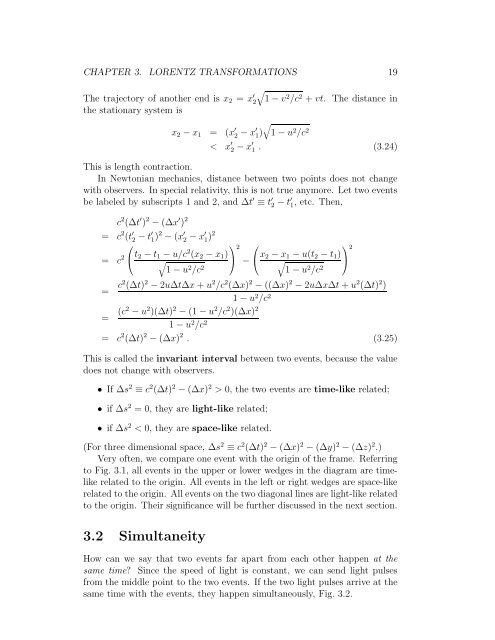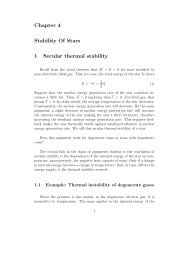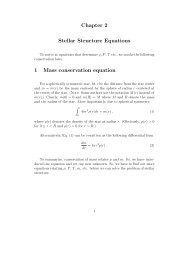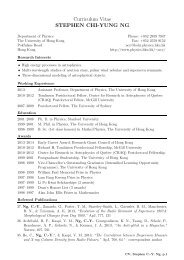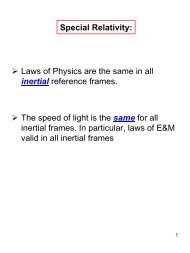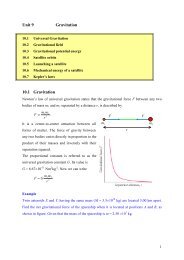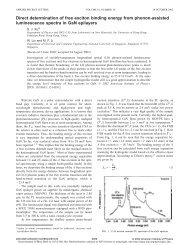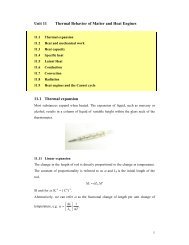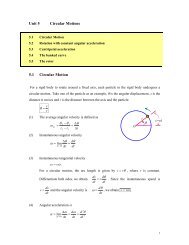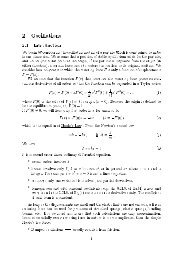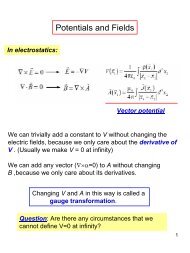here - Department of Physics, HKU
here - Department of Physics, HKU
here - Department of Physics, HKU
You also want an ePaper? Increase the reach of your titles
YUMPU automatically turns print PDFs into web optimized ePapers that Google loves.
CHAPTER 3. LORENTZ TRANSFORMATIONS 19<br />
√<br />
The trajectory <strong>of</strong> another end is x 2 = x ′ 2 1 − v 2 /c 2 + vt. The distance in<br />
the stationary system is<br />
√<br />
x 2 − x 1 = (x ′ 2 − x ′ 1) 1 − u 2 /c 2<br />
< x ′ 2 − x′ 1 . (3.24)<br />
This is length contraction.<br />
In Newtonian mechanics, distance between two points does not change<br />
with observers. In special relativity, this is not true anymore. Let two events<br />
be labeled by subscripts 1 and 2, and ∆t ′ ≡ t ′ 2 − t′ 1 , etc. Then,<br />
c 2 (∆t ′ ) 2 − (∆x ′ ) 2<br />
= c 2 (t ′ 2 − t′ 1 )2 − (x ′ 2 − x′ 1<br />
⎛<br />
)2<br />
⎞<br />
= c 2 ⎝ t 2 − t 1 − u/c 2 (x 2 − x 1 )<br />
√<br />
⎠<br />
1 − u 2 /c 2<br />
2<br />
−<br />
⎛<br />
⎞<br />
⎝ x 2 − x 1 − u(t 2 − t 1 )<br />
√<br />
⎠<br />
1 − u 2 /c 2<br />
= c2 (∆t) 2 − 2u∆t∆x + u 2 /c 2 (∆x) 2 − ((∆x) 2 − 2u∆x∆t + u 2 (∆t) 2 )<br />
1 − u 2 /c 2<br />
= (c2 − u 2 )(∆t) 2 − (1 − u 2 /c 2 )(∆x) 2<br />
1 − u 2 /c 2<br />
= c 2 (∆t) 2 − (∆x) 2 . (3.25)<br />
This is called the invariant interval between two events, because the value<br />
does not change with observers.<br />
• If ∆s 2 ≡ c 2 (∆t) 2 − (∆x) 2 > 0, the two events are time-like related;<br />
• if ∆s 2 = 0, they are light-like related;<br />
• if ∆s 2 < 0, they are space-like related.<br />
(For three dimensional space, ∆s 2 ≡ c 2 (∆t) 2 − (∆x) 2 − (∆y) 2 − (∆z) 2 .)<br />
Very <strong>of</strong>ten, we compare one event with the origin <strong>of</strong> the frame. Referring<br />
to Fig. 3.1, all events in the upper or lower wedges in the diagram are timelike<br />
related to the origin. All events in the left or right wedges are space-like<br />
related to the origin. All events on the two diagonal lines are light-like related<br />
to the origin. Their significance will be further discussed in the next section.<br />
3.2 Simultaneity<br />
How can we say that two events far apart from each other happen at the<br />
same time? Since the speed <strong>of</strong> light is constant, we can send light pulses<br />
from the middle point to the two events. If the two light pulses arrive at the<br />
same time with the events, they happen simultaneously, Fig. 3.2.<br />
2


